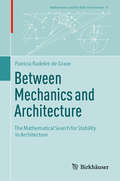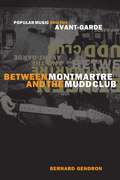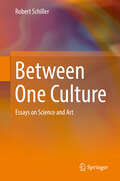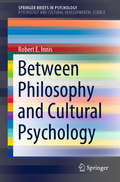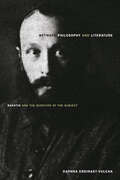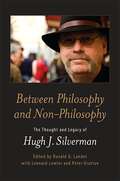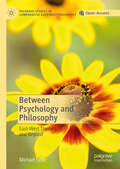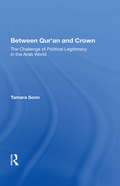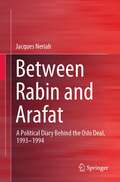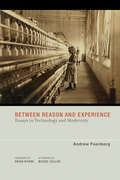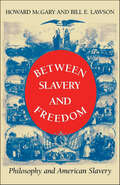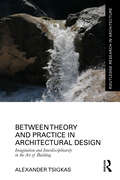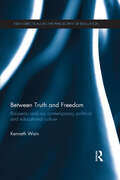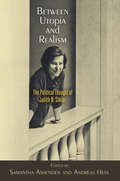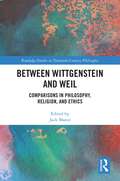- Table View
- List View
Between Man and Man (Routledge Classics)
by Martin BuberScholar, theologian and philosopher, Martin Buber is one of the twentieth century's most influential thinkers. He believed that the deepest reality of human life lies in the relationship between one being and another. Between Man and Man is the classic work where he puts this belief into practice, applying it to the concrete problems of contemporary society. Here he tackles subjects as varied as religious ethics, social philosophy, marriage, education, psychology and art. Including some of his most famous writings, such as the masterful What is Man?, this enlightening work challenges each reader to reassess their encounter with the world that surrounds them.
Between Mechanics and Architecture: The Mathematical Search for Stability in Architecture (Mathematics and the Built Environment #8)
by Patricia Radelet-de GraveThis collection of essays reflects the author's decades-long dedication to studying the interplay between mechanics and architecture. It explores how advancements in mechanics have influenced architectural innovation and how the need for new architectural solutions has driven theoretical progress in engineering. By examining the historical roots of these fields, these essays provide a deep analysis of key developments. This interdisciplinary work will appeal to scholars, students, and anyone interested in the complex relationship between the theoretical and practical aspects of architecture and civil engineering.
Between Montmartre and the Mudd Club: Popular Music and the Avant-Garde
by Bernard GendronDuring the late nineteenth and early twentieth century, popular music was considered nothing but vulgar entertainment. Today, jazz and rock music are seen as forms of art, and their practitioners are regularly accorded a status on par with the cultural and political elite. To take just one recent example, Bono, lead singer and lyricist of the rock band U2, got equal and sometimes higher billing than Pope John Paul II on their shared efforts in the Jubilee 2000 debt-relief project. When and how did popular music earn so much cultural capital? To find out, Bernard Gendron investigates five key historical moments when popular music and avant-garde art transgressed the rigid boundaries separating high and low culture to form friendly alliances. He begins at the end of the nineteenth century in Paris's Montmartre district, where cabarets showcased popular music alongside poetry readings in spaces decorated with modernist art works. Two decades later, Parisian poets and musicians "slumming" in jazz clubs assimilated jazz's aesthetics in their performances and compositions. In the bebop revolution in mid-1940s America, jazz returned the compliment by absorbing modernist devices and postures, in effect transforming itself into an avant-garde art form. Mid-1960s rock music, under the leadership of the Beatles, went from being reviled as vulgar music to being acclaimed as a cutting-edge art form. Finally, Gendron takes us to the Mudd Club in the late 1970s, where New York punk and new wave rockers were setting the aesthetic agenda for a new generation of artists. Between Montmartre and the Mudd Club should be on the shelves of anyone interested in the intersections between high and low culture, art and music, or history and aesthetics.
Between Montmartre and the Mudd Club: Popular Music and the Avant-Garde
by Bernard GendronDuring the late nineteenth and early twentieth century, popular music was considered nothing but vulgar entertainment. Today, jazz and rock music are seen as forms of art, and their practitioners are regularly accorded a status on par with the cultural and political elite. To take just one recent example, Bono, lead singer and lyricist of the rock band U2, got equal and sometimes higher billing than Pope John Paul II on their shared efforts in the Jubilee 2000 debt-relief project. When and how did popular music earn so much cultural capital? To find out, Bernard Gendron investigates five key historical moments when popular music and avant-garde art transgressed the rigid boundaries separating high and low culture to form friendly alliances. He begins at the end of the nineteenth century in Paris's Montmartre district, where cabarets showcased popular music alongside poetry readings in spaces decorated with modernist art works. Two decades later, Parisian poets and musicians "slumming" in jazz clubs assimilated jazz's aesthetics in their performances and compositions. In the bebop revolution in mid-1940s America, jazz returned the compliment by absorbing modernist devices and postures, in effect transforming itself into an avant-garde art form. Mid-1960s rock music, under the leadership of the Beatles, went from being reviled as vulgar music to being acclaimed as a cutting-edge art form. Finally, Gendron takes us to the Mudd Club in the late 1970s, where New York punk and new wave rockers were setting the aesthetic agenda for a new generation of artists.Between Montmartre and the Mudd Club should be on the shelves of anyone interested in the intersections between high and low culture, art and music, or history and aesthetics.
Between Nihilism and Politics: The Hermeneutics of Gianni Vattimo (SUNY series in Contemporary Italian Philosophy)
by Brian Schroeder Silvia BensoThis is the first collection of essays in English that deals directly with the philosophy of Gianni Vattimo from a purely critical perspective, further establishing his rightful place in contemporary European philosophy. Vattimo, who first came to prominence as the translator of Gadamer's Truth and Method into Italian, is now considered to be more than a philosopher and prolific author. As a former member of the European Parliament (1999–2004), he is also a public intellectual. This book takes up his call to advance the crucial active and affirmative engagement with thinking and society. More than just interpretations of Vattimo's thinking, these essays are expressions of the new impetus given to hermeneutic philosophy by "weak thought," the term he coined for how we think now in the wake of Nietzsche, Heidegger, and Gadamer. The development of Vattimo's thinking is reflected in the organization of the volume, divided into three main parts: Hermeneutics and Nihilism, Metaphysics and Religion, and Politics and Technology.
Between One Culture: Essays on Science and Art
by Robert SchillerThis book argues that science and the arts are not two different cultures, but rather different manifestations of the same culture. Divided into seven parts, it presents a collection of translated and revised essays, mostly at the intersection between realia and humaniora. In the first two parts, the author discusses how some myths, both ancient and modern, have become intertwined with scientific ideas. The chapters in the following four parts address poems, novels, plays, and pieces of fine art that have some scientific content, as well as scientific findings which seem to have also been discovered in art. The chapters in the final part examine a number of inspiring doubts and necessary errors in the history of science. This collection of essays, most of which were originally published in Hungarian, is intended for the general public and as such includes no mathematical, physical or chemical formulae. It offers a unique resource for all those curious about the interconnections between science, art and literature.
Between Past and Future: Eight Exercises in Political Thought (Historia, Ciencia, Sociedad Ser. #Vol. 250)
by Hannah Arendt Jerome KohnArendt's penetrating observations of the modern world, based on a profound knowledge of the past, constitute a major contribution to political philosophy. In this book she describes the perplexing crises which modern society faces as a result of the loss of meaning of the traditional key words of politics: justice, reason, responsibility, virtue, and glory. Copyright © Libri GmbH. All rights reserved.
Between Philosophy and Cultural Psychology (SpringerBriefs in Psychology)
by Robert E. InnisThis Brief provides an in-depth discussion of five major points of intersection between philosophy and cultural psychology. The first chapter frames central analytical and normative threads, foregrounding the focal notion of thresholds of sense. The second chapter explores the nature of contexts, situations, and backgrounds of meaning-making following the lead of John Dewey, Ben-Ami Scharfstein, and Gernot Böhme. Chapter three examines the complementary analytical power of the semiotic resources developed in the work of Peirce, Bühler, and Cassirer. Chapter four shows the heuristic fertility and psychological bearing of Susanne Langer's feeling-based aesthetic model of minding. The final chapter establishes affectivation as the inescapable consequence of human beings giving life to themselves by giving life to signs. The Brief concludes with three commentaries from leading researchers in the area. The chapters weave together interlocking themes: the nature of embodied perception, the variety of contexts and semiotic frameworks and their schematization of thresholds of meaning-making, the role of art and theories of imagination both in cultural psychology and in philosophy, and the centrality of feeling in all forms of meaning-making. Between Philosophy and Cultural Psychology will be of interest to cognitive and cultural psychologists as well as researchers and upper-graduate students in philosophy and related psychology fields.
Between Philosophy and Literature: Bakhtin and the Question of the Subject
by Daphna Erdinast-VulcanThis is an original reading of Mikhail Bakhtin in the context of Western philosophical traditions and counter-traditions. The book portrays Bakhtin as a Modernist thinker torn between an ideological secularity and a profound religious sensibility, invariably concerned with questions of ethics and impelled to turn from philosophy to literature as another way of knowing. Most major studies of Bakhtin highlight the fragmented and apparently discontinuous nature of his work. Erdinast-Vulcan emphasizes, instead, the underlying coherence of the Bakhtinian project, reading its inherent ambivalences as an intersection of philosophical, literary, and psychological insights into the dynamics of embodied subjectivity. Bakhtins turn to literature and poetry, as well as the dissatisfactions that motivated it, align him with three other "exilic" Continental philosophers who were his contemporaries: Bergson, Merleau-Ponty, and Levinas. Adopting Bakhtins own open-ended approach to the human sciences, the book stages a series of philosophical encounters between these thinkers, highlighting their respective itineraries and impasses, and generating a Bakhtinian synergy of ideas.
Between Philosophy and Non-Philosophy: The Thought and Legacy of Hugh J. Silverman
by Donald A. Landes; Leonard Lawlor; Peter GrattonHugh J. Silverman was an inspiring scholar and teacher, known for his work engaging and shaping phenomenology, hermeneutics, psychoanalysis, structuralism, poststructuralism, and deconstruction. As Professor of Philosophy and Comparative Literary and Cultural Studies at Stony Brook University, State University of New York, Silverman's work was marked by "the between," a concept he developed to think the postmodern in the space between philosophy and non-philosophy. In this volume, leading scholars explore and extend Silverman's philosophical contributions, from reflections on the notions of care, time, and responsibility, to presentations of the practices and possibilities of deconstruction itself. They provide an assessment of Silverman's life and work at the intersection of philosophy, ethics, and politics.
Between Philosophy and Theology: Contemporary Interpretations of Christianity
by Christophe BrabantLong past the time when philosophers from different perspectives had joined the funeral procession that declared the death of God, a renewed interest has arisen in regard to the questions of God and religion in philosophy. The turn to secularization has produced its own opposing force. Although they declared themselves from the start as not being religious, thinkers such as Derrida, Vattimo, Zizek, and Badiou have nonetheless maintained an interest in religion. This book brings some of these philosophical views together to present an overview of the philosophical scene in its dealings with religion, but also to move beyond the outsider's perspective. Reflecting on these philosophical interpretations from a fundamental theological perspective, the authors discover in what way these interpretations can challenge an understanding of today's faith. Bringing together thinkers with an established reputation - Kearney, Caputo, Ward, Desmond, Hart, Armour - along with young scholars, this book challenges a range of perspectives by putting them in a new context.
Between Psychology and Philosophy: East-West Themes and Beyond (Palgrave Studies in Comparative East-West Philosophy)
by Michael SloteThis open access book discusses a variety of important but unprecedented ways in which psychology can be useful to philosophy. The early chapters illustrate this theme via comparisons between Chinese and Western philosophy. It is argued that the Chinese notion of a heart-mind is superior to the Western concept of mind, but then, more even-handedly, the relative strengths and weaknesses of Chinese and Western thought overall are critically examined. In later chapters, the philosophical uses of psychology are treated more specifically in relation to major issues in Western philosophy. Michael Slote shows that empathy and emotion play a role in speech acts (like assertion and thanking) that speech act theory has totally ignored. Similarly, he treats the age-old question of whether justice pays using psychological material that has not previously been recognized. Finally, the implications of psychological egoism are discussed in terms of some new psychological and, indeed, human distinctions. Human life is pervaded by instincts and aspirations that are neither egoistic nor altruistic, and recognizing that fact can help put egoism in its place. It is less of a challenge to morality than we have realized.
Between Psychology and Psychotherapy: A Poetics of Experience (Psychology Revivals)
by Miller MairIn this highly original and thought-provoking work the late Miller Mair puts forward his ideas for a new psychology. First published in 1989, he deals with issues of fundamental importance to the future of a psychology guided by genuine enquiry and concern rather than mere professional self-interest. Crossing and re-crossing boundaries between psychology, psychotherapy and philosophy, and between ‘science’ and ‘art’, he demonstrates the linkages between the personal and the impersonal, subject and object, inside and outside, with a daring not previously risked by anyone working in the area. Dr Mair stresses the importance of a poetic approach in psychology and psychotherapy, and the need to explore and understand the nature of psychology through an imaginative freedom of language. He emphasizes that a poetic awareness and attentiveness is fundamental to any pursuit of understanding of ourselves or others. This is a very personal book, concerned with personal knowledge, but it is meant for anyone who seeks to understand themselves and others, and what is involved in coming to such understanding. Focusing on ordinary human experience, and moving towards literary and artistic modes of expression, the author invites you to enter in, follow what you think and feel, as he proposes a radical revision of much that is accepted in psychology and in psychotherapy.
Between Qur'an And Crown: The Challenge Of Political Legitimacy In The Arab World
by Tamara SonnThe struggle for political legitimacy in many Middle Eastern countries today poses a dilemma for ruling elites. In order to maintain authority, leaders often must capitulate to Islamic universalist dogma, which may conflict with their own views of the state as well as threaten the legitimacy of other leaders in the region who are attempting to establish a secular, national basis for government. Tracing the roots of this dilemma in Middle Eastern history and Islamic philosophy, Dr. Sonn compares the contemporary Middle Eastern period to Europe’s “Age of Religious Wars†that preceded the emergence of the Western secular state. She describes how a process similar to the organic development of the secular state in Europe was interrupted in the Middle East by oppressive Western colonialism, which eventually led to the Muslim rejection of nationalism and all things “Western†and to the reassertion of Islam as the sole source of political legitimacy. The author shows how the philosophy of Islamic traditionalism opposes the two fundamentals of stable national political systems—a geographical limitation of authority and an institutionalized process for regular changes in leadership. Dr. Sonn bases her argument on an insightful examination of Middle Eastern history, from the formation and disintegration of the Ottoman Empire in the late nineteenth century to the present, and caps it with a detailed look at a possible solution to the dilemma: the teachings of modern scholars who advocate a new “Islamic realism†incorporating a limited definition of national identity and interests while retaining Islamic social goals.
Between Rabin and Arafat: A Political Diary Behind the Oslo Deal, 1993–1994
by Jacques NeriahThis book shares first-hand insights into the implementation of the Oslo Accords between Israel and the Palestinians, written by a high-ranking Israeli military intelligence officer and former foreign policy advisor to Israel’s fifth prime minister, Yitzhak Rabin. It offers a diary of the political events surrounding the Israeli prime minister in 1993–1994, focusing on a key turning point in the Israeli-Arab conflict – those crucial days when Rabin had to choose between promoting a peace process with the Palestinians or trying to strike a deal with the Syrians and waiting for the Jordanians to join. The book sheds new light on Rabin’s attitudes towards the Palestinians, on his meetings with Yasser Arafat, and on what went on behind the scenes of the official diplomatic negotiations. Readers will learn about the power struggles and ego-driven rivalries between Israeli politicians and high-ranking generals, about the relationship between politicians and the media, and about problems such as the leaking of sensitive information to the press. This book will be of interest not only to scholars, but also and more importantly to policymakers around the world, and to anyone interested in the Israeli-Palestinian conflict and finding a two-state solution in the region.“A vital and extremely well-written book, not only for the academia, but above all for the decision makers across the globe, West and East, North and South, in fact anyone who talks about a two-state solution in the region". Arno Tausch, Professor of Political Science, Innsbruck University, Austria
Between Reason and Experience: Essays in Technology and Modernity (Inside Technology)
by Andrew FeenbergA leading philosopher of technology calls for the democratic coordination of technical rationality with everyday experience.The technologies, markets, and administrations of today's knowledge society are in crisis. We face recurring disasters in every domain: climate change, energy shortages, economic meltdown. The system is broken, despite everything the technocrats claim to know about science, technology, and economics. These problems are exacerbated by the fact that today powerful technologies have unforeseen effects that disrupt everyday life; the new masters of technology are not restrained by the lessons of experience, and accelerate change to the point where society is in constant turmoil. In Between Reason and Experience, leading philosopher of technology Andrew Feenberg makes a case for the interdependence of reason—scientific knowledge, technical rationality—and experience. Feenberg examines different aspects of the tangled relationship between technology and society from the perspective of critical theory of technology, an approach he has pioneered over the past twenty years. Feenberg points to two examples of democratic interventions into technology: the Internet (in which user initiative has influenced design) and the environmental movement (in which science coordinates with protest and policy). He examines methodological applications of critical theory of technology to the case of the French Minitel computing network and to the relationship between national culture and technology in Japan. Finally, Feenberg considers the philosophies of technology of Heidegger, Habermas, Latour, and Marcuse. The gradual extension of democracy into the technical sphere, Feenberg argues, is one of the great political transformations of our time.
Between Slavery and Freedom: Philosophy and American Slavery (Blacks in the Diaspora)
by Bill E. Lawson Howard McGaryUsing the writings of slaves and former slaves, as well as commentaries on slavery, Between Slavery and Freedom explores the American slave experience to gain a better understanding of six moral and political concepts—oppression, paternalism, resistance, political obligation, citizenship, and forgiveness. The authors use analytical philosophy as well as other disciplines to gain insight into the thinking of a group of people prevented from participating in the social/political discourse of their times.Between Slavery and Freedom rejects the notion that philosophers need not consider individual experience because philosophy is "impartial" and "universal." A philosopher should also take account of matters that are essentially perspectival, such as the slave experience. McGary and Lawson demonstrate the contribution of all human experience, including slave experiences, to the quest for human knowledge and understanding.
Between Theory and Practice in Architectural Design: Imagination and Interdisciplinarity in the Art of Building (Routledge Research in Architecture)
by Alexander TsigkasBetween Theory and Practice in Architectural Design: Imagination and Interdisciplinarity in the Art of Building examines the intersection of philosophy and practice in architecture, exploring life, viability, and interdisciplinary collaboration and offering practical design insights for all beings.This book highlights several key architectural features, including a philosophical exploration of life, a focus on creating organic spaces, and the use of the viable system model (VSM) for organisational resilience. Additionally, it emphasises interdisciplinary design thinking and introduces a platform for viable and agile AI-assisted design. The book provides practical case studies highlighting how theory and practice can be integrated into architectural projects, giving architects actionable insights for innovative, adaptive, and purposeful design. By utilising organic design principles and interdisciplinary collaboration, readers will gain a transformative understanding of architecture. The book encourages the application of the viable system model to enhance organisational viability while promoting flexibility and viability in design. Furthermore, architects are encouraged to use logic-based and object-oriented ontology (OOO)-based AI-assisted design approaches due to their ability to evaluate design scenarios quickly.This book will be of interest to architects, designers, and enthusiasts seeking a comprehensive understanding of architecture, and professionals in architectural enterprises looking to enhance organisational viability will find value. Interdisciplinary collaboration is emphasised throughout the book. Students and academics in architecture and related fields will also benefit from its philosophical exploration and practical insights.
Between Theory and Practice: Essays on Criticism and Crises of Democracy (Challenges to Democracy in the 21st Century)
by Eerik Lagerspetz Oili PulkkinenIs it possible, in the complex modern world, to have a government ‘by the people’? Does, for example, digital technology help us to bring the reality closer to the ideal? Or does it actually make the ideal unattainable?The volume brings together conceptual historians, philosophers, political theorists and sociologists to discuss the criticisms and crises of democracy with fresh approaches to the idea of democracy, democratic theory, democratic institutions, trust and distrust, populism, and advancement of technologies in Western societies.
Between Truth and Freedom: Rousseau and our contemporary political and educational culture (New Directions in the Philosophy of Education)
by Kenneth WainThis book engages in a broad reading of Rousseau’s writings on educational and political thought in order to explore and address the competing demands of the enculturation and individuation of the young in Western societies. Although Rousseau’s Emile has been frequently utilised in educational debate, much of his other work has been largely neglected, as too has the relationship between his educational and political thinking, which this work seeks to redress. Drawing on the thinking of philosophers Foucault and Richard Rorty, the book considers the public and private conflicts of education and politics in modern societies, treating them as the tension between the demands of truth and freedom. This tension exists across a range of educational and political systems, such as teaching in and by the family, school, the government and, separately, for women. Wain suggests that the conflict between truth and freedom began with Rousseau and remains a central challenge in our contemporary world of political and educational thought. This book’s examination of the public and private roles in education and politics can enhance our understanding of modern educational systems and current political nihilism. Between Truth and Freedom provides an analysis of Rousseau’s position on the politics of education, arguing that his thoughts were much wider and more sophisticated than the ideas presented in Emile imply. This new consideration of the work of a classic figure will appeal to researchers and academics in the fields of the philosophy of education and political education.
Between Two Worlds: A Reading of Descartes's Meditations
by John CarrieroBetween Two Worlds is an authoritative commentary on--and powerful reinterpretation of--the founding work of modern philosophy, Descartes's Meditations. Philosophers have tended to read Descartes's seminal work in an occasional way, examining its treatment of individual topics while ignoring other parts of the text. In contrast, John Carriero provides a sustained, systematic reading of the whole text, giving a detailed account of the positions against which Descartes was reacting, and revealing anew the unity, meaning, and originality of the Meditations. Carriero finds in the Meditations a nearly continuous argument against Thomistic Aristotelian ways of thinking about cognition, and shows more clearly than ever before how Descartes bridged the old world of scholasticism and the new one of mechanistic naturalism. Rather than casting Descartes's project primarily in terms of skepticism, knowledge, and certainty, Carriero focuses on fundamental disagreements between Descartes and the scholastics over the nature of understanding, the relation between the senses and the intellect, the nature of the human being, and how and to what extent God is cognized by human beings. Against this background, Carriero shows, Descartes developed his own conceptions of mind, body, and the relation between them, creating a coherent, philosophically rich project in the Meditations and setting the agenda for a century of rationalist metaphysics.
Between Two Worlds: Black Students in an Urban Community College (Routledge Library Editions: Urban Education #4)
by Lois WeisFirst published in 1985, this book explores the ‘lived culture’ of urban black students in a community college located in a large northeastern city in the United States. The author immersed herself in the institution she was studying for a full academic year, exploring both the direct experiences of education, and the way these experiences were worked over and through the praxis of cultural discourse. She examines in detail the messages of the school, including the ‘hidden curriculum’ and faculty perspectives, as well as the way these messages are transformed at a cultural level. The resulting work provides a major contribution to a number of debates on education and cultural and economic reproduction, as well as a leap forward in our understanding of the role schooling plays in the re-creation of race and class antagonisms. This work will be of great interest to anyone working with minorities, particularly in the context of education.
Between Two Worlds: Memoirs of a Philosopher-Scientist (Springer Biographies)
by Mario BungeTo go through the pages of the Autobiography of Mario Bunge is to accompany him through dozens of countries and examine the intellectual, political, philosophical and scientific spheres of the last hundred years. It is an experience that oscillates between two different worlds: the different and the similar, the professional and the personal. It is an established fact that one of his great loves was, and still is, science. He has always been dedicated to scientific work, teaching, research, and training men and women in multiple disciplines. Life lessons fall like ripe fruit from this book, bringing us closer to a concept, a philosophical idea, a scientific digression, which had since been uncovered in numerous notes, articles or books. Bunge writes about the life experiences in this book with passion, naturalness and with a colloquial frankness, whether they be persecutions, banishment, imprisonment, successes, would-be losses, emotions, relationships, debates, impressions or opinions about people or things. In his pages we pass by the people with whom he shared a fruitful century of achievements and incredible depths of thought. Everything is remembered with sincerity and humor. This autobiography is, in truth, Bunge on Bunge, sharing everything that passes through the sieve of his memory, as he would say. Mario's many grandchildren are a testament to his proud standing as a family man, and at the age of 96 he gives us a book for everyone: for those who value the memories that hold the trauma of his life as well as for those who share his passion for science and culture. Also, perhaps, for some with whom he has had disagreements or controversy, for he still deserves recognition for being a staunch defender of his convictions.
Between Utopia and Realism: The Political Thought of Judith N. Shklar (Haney Foundation Series)
by Samantha Ashenden Andreas HessFrom her position at Harvard University's Department of Government for over thirty-five years, Judith Shklar (1928-92) taught a long list of prominent political theorists and published prolifically in the domains of modern and American political thought. She was a highly original theorist of liberalism, possessing a broad and deep knowledge of intellectual history, which informed her writing in interesting and unusual ways. Her work emerged between the "end of ideology" discussions of the 1950s and the "end of history" debate of the early 1990s. Shklar contributed significantly to social and political thought by arguing for a new, more skeptical version of liberalism that brought political theory into close contact with real-life experience.The essays collected in Between Utopia and Realism reflect on and refract Shklar's major preoccupations throughout a lifetime of thinking and demonstrate the ways in which her work illuminates contemporary debates across political theory, international relations, and law. Contributors address Shklar's critique of Cold War liberalism, interpretation of Montaigne and its connection to her genealogy of liberal morals, lectures on political obligation, focus on cruelty, and her late reflections on exile. Others consider her role as a legal theorist, her interest in literary tropes and psychological experience, and her famed skepticism.Between Utopia and Realism showcases Shklar's approach to addressing the intractable problems of social life. Her finely honed political skepticism emphasized the importance of diagnosing problems over proffering excessively optimistic solutions. As this collection makes clear, her thought continues to be useful in addressing cruelty, limiting injustice, and combating the cynicism of the present moment.Contributors: Samantha Ashenden, Hannes Bajohr, James Brown, Katrina Forrester, Volker M. Heins, Andreas Hess, Samuel Moyn, Thomas Osborne, William E. Scheuerman, Quentin Skinner, Philip Spencer, Tracy B. Strong, Kamila Stullerova, Bernard Yack.
Between Wittgenstein and Weil: Comparisons in Philosophy, Religion, and Ethics (Routledge Studies in Twentieth-Century Philosophy)
by Jack ManziThis volume explores the relationship between the philosophical thought of Simone Weil and Ludwig Wittgenstein. The contributions shed light on how reading Weil can inform our understanding of Wittgenstein, and vice versa. The chapters cover different aspects of Weil’s and Wittgenstein’s philosophy, including their religious thought and their views on ethics and metaphilosophy. They address the following questions: How does Wittgenstein’s struggle with religious belief match up with Simone Weil’s own struggle with organised belief? What is the role of the mystical and supernatural in their works? How much impact has various posthumous editorial decisions had on the shaping of Weil’s and Wittgenstein’s thought? Is there any significance to similarities in Weil’s and Wittgenstein’s written and philosophical styles? How do Weil and Wittgenstein conceive of the ‘self’ and its role in philosophical thinking? What role does belief play in Weil’s and Wittgenstein’s respective philosophical works? Between Wittgenstein and Weil will be of interest to scholars and advanced students working in twentieth-century philosophy, philosophy of religion, philosophy of language, and the history of moral philosophy.

